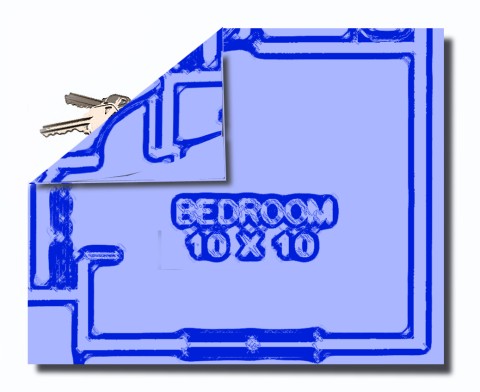A room is 10 x 10. The space seems small, relatively, once there is a bed and a table and things like clothing and stuffed animals and books and people and other things that you put inside of a room to make it seem as if you are alive; you are a person that lives; you are a person that lives in that space.
If you laid some people down on the floor, you could not lay multiple people, not even two people, along each wall, unless they were excessively short, unless they were each shorter than five feet tall, unless they curled their knees up and scrunched themselves down to sizes that they are usually not. These people you laid down against the walls, they could not stretch out, the eight of them. This is how you know that a room that is 10 x 10 is a small room, relatively.
It is a small room until something gets lost, like a key, or like a note, or like a cellular phone, and then the object you lost, which never seemed particularly small, even if you did have to occasionally dig in your pocket or your purse for it, even if it did not always present itself immediately from a space, this object like the phone or like the key, it becomes smaller, and the room becomes larger, and you wonder how it is that you never noticed how large the space is, relatively, to the other things, to the things that are not people, to these things that you could lay end to end against the walls, in multiples greater than two. These things, like hamsters and bunny rabbits and cats and children, these things could be laid end to end without bending knees, and these things could get lost inside of a room, in a way like a key or note or a phone, in a way that a person never could.
And the size of a room, which can expand or contract, relative to the situation, even though this expansion and contraction is a psychological effect, and not a physiological effect of the elasticity of the walls, this expansion and contraction of space is what we compare to a vagina, when we talk about lost things and the vagaries of space, although the things we talk about losing in a vagina are not keys or cell phones or children, are instead tampons and condoms, although those different types of things, I suppose, are not exclusive to those spaces. We have lost condoms in rooms and I’m sure someone I know has lost a key in a vagina, even if I have not heard the story of it yet.
What we are surprised by, when we discuss it, is the relative space of the vagina, and the similarities of experience, and the realization that a thing can, in fact, be lost inside of a vagina, a thing that was deliberately placed there for a specific function can be lost, and the confusion and disease that is associated with an object being lost inside of a body, and that yes, this is a space that can expand and can create room roughly the size of a newborn but, Really? I have lost an object? Has it disappeared? To what extent can I use my fingernails as a grappling hook? How many places can a condom hide inside of a vagina? How much can a tampon actually condense if I am drunk and forget that it’s there and have sex anyway? Will I have to go to a hospital if I cannot find the object? How long do I wait until I visit the hospital, and then, there it is, between the clutching talons of fingernail, and using the fingernails like that hurts a little bit, sure, but it is so much better than a visit to the hospital, and so you shout from behind the closed bathroom door “I’ve found it! I feel like Indiana Jones!” and it’s funny in a way that a lost key in a bedroom is never ever funny, and you pretend that you are not bewildered, although you are bewildered by it for the rest of the day, and when you finally mention it to a girlfriend a few days later, she expresses a similar story with a similar sense of bewilderment, and on and on and on until you all wonder why you are so bewildered by something that happens so often.



 The core workshop of SmokeLong Fitness is all in writing, so you can take part from anywhere at anytime. We are excited about creating a supportive, consistent and structured environment for flash writers to work on their craft in a community. We are thrilled and proud to say that our workshop participants have won, placed, or been listed in every major flash competition. Community works.
The core workshop of SmokeLong Fitness is all in writing, so you can take part from anywhere at anytime. We are excited about creating a supportive, consistent and structured environment for flash writers to work on their craft in a community. We are thrilled and proud to say that our workshop participants have won, placed, or been listed in every major flash competition. Community works.